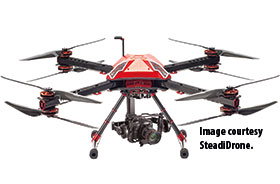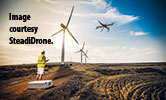

The first serious use of a helicopter drone for inspection duties on a petrochemical plant in the UK was reported around five years ago, from Cyberhawk, based in Edinburgh, and initially focused on the petrochemical and oil industry in Scotland and the Northern UK, plus offshore in the North Sea. Cyberhawk undertook the world’s first live gas flare inspection, using an ROAV (Remotely Operated Aerial Vehicle) flying at a height of 100 m: this work was for a major Scottish gas refinery. The ROAV was flown within a few metres of the live flare: this provided highly detailed images of the condition of the flare tip and associated structure using HD video, plus still imagery and thermal imaging equipment. More important was that the work on site was carried out by Cyberhawk inspection engineers – all CSWIP (Certification Scheme for Welding and Inspection Personnel) qualified, who knew what they were looking for, and what was important.
Cyberhawk has expanded, and established operating bases in Norway, Malaysia and Abu Dhabi: they recently carried out their 10 000th commercial ROAV flight, which was a survey of a new power station site. The helicopter drone used was an 8 rotor type incorporating the latest triple redundant autopilot, a significantly more expensive unit than a gadget shop drone! In the USA, Aetos, a Michigan based company, has been granted a special exemption by the FAA to operate drones commercially for inspections of petrochemical plants and facilities. The Aetos CEO, Bill Donberg, had done 30 years working at Dow Chemical, and their first clients included the likes of Dow Chemical, Eastman Chemical, Exxon Mobil and Phillips 66. Their drones are built by Aeryon, and cost around $75 000 each. The final FAA regulations covering commercial drone flights and their pilots are expected to be issued in late 2016 or 2017, but already their other ‘special exemptions’ allow specific drone use in the movie and video industry; for real estate adverts; for agricultural monitoring and aerial surveying.
Drone flying regulation
Regulations generally accept that a landowner owns his own airspace, up to say 91 m upwards at least, so that makes flying a drone over your property, for example to look in your windows, not permissible. The push by paparazzi photographers using drones to get ‘at home’ celebrity photos needs to be quashed. So regulations require that drones cannot fly over anywhere without the landowner’s permission. Incidentally, this brings the FAA in the USA up against Amazon, who want to trial delivery systems using drones: Amazon has threatened to move their R&D on this topic out of the USA, unless there is some progress to gaining FAA agreement. Google are doing their drone delivery system research project in Australia.

In the UK, if you intend to fly a camera equipped drone for commercial uses you will need a PfAW (Permission for Aerial Work) from the CAA. This is issued after the requisite training of the pilot has been completed, and it is renewable annually, for a fee: several providers of approved training courses are operating. The website www.droneuav.co.uk gives useful data and links: there Ben Lovegrove of www.WessexAerialPhotography.com describes from his own experience that the training took six months and the total cost to gain the UK PfAW including accessories and insurance was around &163;3000. Ben often uses a drone made by a South African company, SteadiDrone, which is based in Knysna.
In South Africa, new regulations for operating drones were announced in May by the CAA. These regulations took effect from 1 July. They follow the same patterns as being imposed in the USA and UK, and will require an operator to have a Remote Pilots License (RPL). A lot of useful information can be found on www.safedrone.co.za.
Recent applications
Many recent industrial applications use and show the capabilities of the camera equipped drone: from the beginnings of inspecting flare stacks, many more inspections have been made of offshore structures, for example oil platform legs – anywhere where putting a man up alongside the area to be inspected is difficult and hazardous. The Royal Navy has used them to inspect the external hull areas of warships. In the UK there are many old buildings, and regrettably many of these are damaged by fire. Long after the event, structural engineers can do a detailed survey of the damage to the internal walls by flying a drone inside the building, to assess whether it is safe for engineers to enter the shell of the building at all.
The technologies now added to the drone include infrared thermal cameras, and GPS positioning linked into the drone flying controls, to accurately position the drone, know where it is, and keep it there. These aspects can help searches for hot spots (i.e. electrical faults) on solar power farms, or electricity distribution networks, and for locating steam or gas leaks – or insulation failures – on petrochemical plant pipework.
Some of the start-up companies providing drone inspection services seem to emerge from research projects based in university departments. A typical surprising application was described at InnoRobo, the robot technology exhibition in Lyon in March 2014. Philippe Bidaud of GdR-Robotique, the French co-ordinating body for robotics research in government institutions, reported on the use by CNRS (the French Railways) of drones on civil engineering survey work: monitoring railway lines across bridges and other structures from the air. Flying at 150 m, these drones can monitor rail line positioning to within 2 mm. In The Netherlands, a company spun out of the Aerospace Engineering Department from the Delft University of Technology has specialised in building robot helicopters: their latest multi-copter will automatically take-off and land from a transport box, so reducing the workload for the operator. The university has also pioneered various research projects to improve the situational awareness of the operators of these drones to other air traffic, so that they can be used more effectively for police and military operations in urban areas. Further partners are being sought for this work, as well as other industrial inspection and maintenance tasks.
The future

As ever, once the technology and operational rules have been established, the potential for many new drone applications will arise. New markets for drone services are going to open up for service providers, and these will be pioneered by the specialists who have a problem or a project, and can make the link with friends or service providers: it is the combination of the drone pilot and the corrosion engineer, structural engineer, or another inspection or measurement technologist who needs to get his eyes up close or into a difficult environment that will make the break-through.
Nick Denbow spent thirty years as a UK-based process instrumentation marketing manager, and then changed sides – becoming a freelance editor and starting Processingtalk.com. Avoiding retirement, he published the INSIDER automation newsletter for five years, www.iainsider.com, and now acts as its EMEA editorial correspondent. His blog is on www.nickdenbow.com.

© Technews Publishing (Pty) Ltd | All Rights Reserved